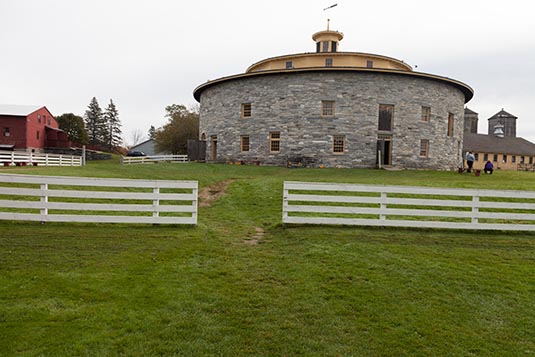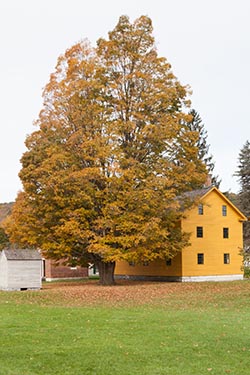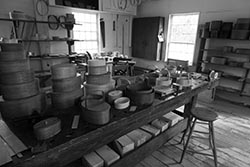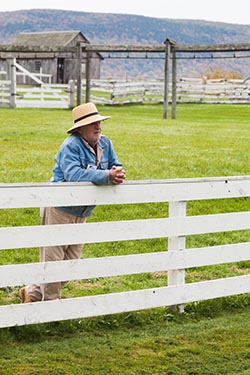 |
Home | Charity | Feedback |
USA: Massachusetts:
Boston,
Mount Greylock,
Pittsfield
Pittsfield, Massachusetts, USA: Hancock Shaker Village by Prakash Bang, Editor in Chief  It's a place to soak into the early years of American history, religion and culture. In 1774, Mother Ann Lee made the monumental decision to lead eight Shaker converts on a journey to America, seeking the freedom to live, work, and worship according to their main religious tenets: celibacy, communal life, and confession of sin. The Shakers also believed in racial and gender equality, simplicity, and pacifism. They dedicated their lives to creating a working Heaven on Earth amidst the boundless opportunities presented by settlement of the New World.  I left Arlington, post breakfast and drove for an hour to reach the gates of Hancock Shaker Village located in Pittsfield. It was an hour's drive. I was hosted for a guided tour at 10AM. Generally, visitors can opt for guided tours (check schedule) or can easily do a self-guided tour. The visit is bound to enrich those curious. A couple of hours should do the trick.
I left Arlington, post breakfast and drove for an hour to reach the gates of Hancock Shaker Village located in Pittsfield. It was an hour's drive. I was hosted for a guided tour at 10AM. Generally, visitors can opt for guided tours (check schedule) or can easily do a self-guided tour. The visit is bound to enrich those curious. A couple of hours should do the trick.
Hancock was the third of what would eventually number nineteen major Shaker communities established between 1783 and 1836 in New York, New England, Kentucky, Ohio and Indiana. The Shaker population reached its peak in the mid-19th century, with an estimated 4,000 to 5,000 Shakers. The Shakers trace their beginnings to Manchester, England, in 1747. They called themselves The United Society of Believers in Christís Second Appearing. They soon became known as Shakers because of the trembling, whirling, and shaking that affected them during their spiritually ecstatic worship services. They believed that Christís second coming was realized in their leader, Ann Lee, whom they called Mother Ann. Misunderstood and persecuted in their native England, the Shakers nonetheless gathered a small group of enthusiastic followers to their new Christian lifestyle and beliefs.  The Shakers are one of the most intriguing social and religious movements in American history. They are also one of the longest lived, and are considered by many to be the most successful of the hundreds of communal groups and utopian societies that have flourished in this country since before the Revolutionary War. As the Shakers grew in influence and in numbers in the 19th century, they challenged the existing social and religious structure and economic order of the new nation. Eventually developing an alternative lifestyle based on their religious beliefs, the Shakers have made important contributions to American culture including art, science, architecture, craftsmanship, business, music, education, government, medicine, agriculture, and commerce.
The Shakers are one of the most intriguing social and religious movements in American history. They are also one of the longest lived, and are considered by many to be the most successful of the hundreds of communal groups and utopian societies that have flourished in this country since before the Revolutionary War. As the Shakers grew in influence and in numbers in the 19th century, they challenged the existing social and religious structure and economic order of the new nation. Eventually developing an alternative lifestyle based on their religious beliefs, the Shakers have made important contributions to American culture including art, science, architecture, craftsmanship, business, music, education, government, medicine, agriculture, and commerce.
 Hancock Shaker Village began in the late 1780s, when nearly 100 Believers consolidated a community on land donated by local farmers who had converted to the Shaker movement. By the 1830s, with a great many more conversions and further land acquisitions, the community had peaked in population with more than 300 Believers and more than 3,000 acres.
Hancock Shaker Village began in the late 1780s, when nearly 100 Believers consolidated a community on land donated by local farmers who had converted to the Shaker movement. By the 1830s, with a great many more conversions and further land acquisitions, the community had peaked in population with more than 300 Believers and more than 3,000 acres.
During their peak period of growth and religious fervor, the Hancock Shakers erected communal dwelling houses, barns, workshops, and other buildings, and developed a large and successful farm. With the 1826 Round Stone Barn as the center of a thriving dairy industry, and with many acres of medicinal herbs, vegetables, fruits, and other crops, the Hancock Shakers enjoyed a simple, peaceful, and hard-working lifestyle, separated from the ways of the World. They named their utopian village The City of Peace, and organized the large community into six smaller communal groups known as Families for efficiency of work, worship, and administration. The Shakers developed a wide variety of crafts, trades, and industries, including woodworking and metalworking, basketry, broom making, and much more. They developed their own water-powered mills for grinding grain, sawing wood, and manufacturing textiles. The Shakers were highly regarded for their honesty and industriousness, and for the quality of their products, which were marketed throughout the region as an important source of income for the communal society. Their genius was obvious as I walked through the-ahead-of-their-times infrastructure. It was 12 noon by the time I finished my tour of this beautiful village. It was time to say goodbye and proceed to my next destination of the day Ė Mount Greylock. Pittsfield Image Gallery  Photo viewer Photo viewer
|
|
|
Home |
Charity |
Feedback
Privacy Policy | Terms of Usage © YoGoYo.com. All rights reserved. |

















